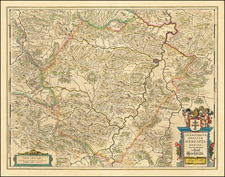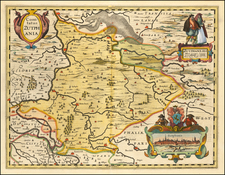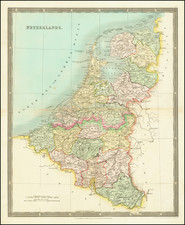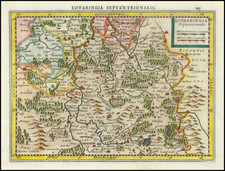Mapping The Regions Impacted by the Succession of Juliers
A very rare political map produced by the Chevalier De Beaurain, focusing on a region of Western Europe that was embroiled in political machinations and territorial disputes during the early modern period.
The map shows the area between Cleves, Eifel, the course of the Meuse River, and the Bergisches Land with Radevormwald in the east. At the top right is the title cartouche; directly below it is the scale. At the bottom right is an inset map of the Bergisch area on the Sieg River. At the bottom left is a cartouche with a note about the Duchy of Jülich and Berg.
Both the Duchés de Juliers and de Berg were historically part of the Holy Roman Empire, situated in what is now western Germany. By 1742, they were part of the territories held by the Elector Palatinate. Charles III Philip, Elector Palatine, was the ruler of these territories until his death in 1742, after which they passed to Charles IV Theodore.
The Duchy of Cleves, situated in modern North Rhine-Westphalia, Germany, was associated with the Electorate of Brandenburg in 1742. Frederick II (Frederick the Great) was the ruler by that year. As King of Prussia, he played a significant role in shaping the European landscape.
The Electorate of Cologne was an ecclesiastical principality of the Holy Roman Empire. By 1742, Clemens August of Bavaria held the position of the Archbishop-Elector of Cologne. Limbourg, a historical duchy located between modern Belgium, Germany, and the Netherlands, was under Austrian Habsburg control in the 1740s. Maria Theresa was the ruler following the Pragmatic Sanction of 1713. The Upper Guelders or Haute Gueldre, a part of the Duchy of Guelders, was fragmented by 1742, with parts being under Prussian and Austrian control.
The region depicted in the map was significantly affected by the War of the Austrian Succession (1740-1748), with alliances influencing the control and borders of the territories.
Succession de Juliers
The "Succession de Juliers" refers to a series of disputes and wars over the succession rights to the United Duchies of Jülich-Cleves-Berg, which comprised the territories of Jülich, Cleves, Berg, and other smaller regions. These territories, situated in the western parts of modern-day Germany and the Netherlands, became a focal point of European politics in the early 17th century due to their strategic importance. Here is a brief history:
1. The Spark of Controversy: The succession crisis began with the death of John William, the last Duke of Jülich-Cleves-Berg, in 1609. He died childless, leading to a significant question: who should inherit his vast and strategically positioned territories?
2. Claimants: There were multiple claimants to these territories:
- Wolfgang William of Palatinate-Neuburg: He was John William's brother-in-law and asserted his claim on the basis of his marriage to Magdalena, John William's sister.
- John Sigismund of Brandenburg: He had a claim as he was married to Anna, another one of John William's sisters.
- There were also claims by the counts of Moers and the dukes of Saxony, but these were weaker compared to the first two.
3. The Jülich-Cleves War of Succession: Tensions over the territories erupted into open conflict in 1609, often termed the War of the Jülich Succession. Various European powers took sides in this dispute. The Catholic Holy Roman Emperor Rudolf II backed Wolfgang William, while the Protestant Union supported John Sigismund.
4. Treaty of Xanten: The war ended relatively quickly in 1614 with the Treaty of Xanten. The territories were divided between the two primary claimants:
- Wolfgang William received the Duchy of Jülich and Berg.
- John Sigismund got the Duchy of Cleves and the County of Mark.
5. Lasting Implications: The Succession of Jülich was not just a regional matter. It was part of the broader tensions that would eventually lead to the Thirty Years' War (1618-1648). The territories continued to play a significant role in European geopolitics, and the divides of the treaty would lay the groundwork for the eventual formation of modern German states like North Rhine-Westphalia.
In summary, the Succession de Juliers was a significant episode in European history, emblematic of the broader political and religious tensions of the early 17th century. It involved not just regional but also major European powers, each with vested interests in the outcome of the dispute.









![[ Holy Roman Empire ] Germania del Gastaldo](https://storage.googleapis.com/raremaps/img/small/73754.jpg)




